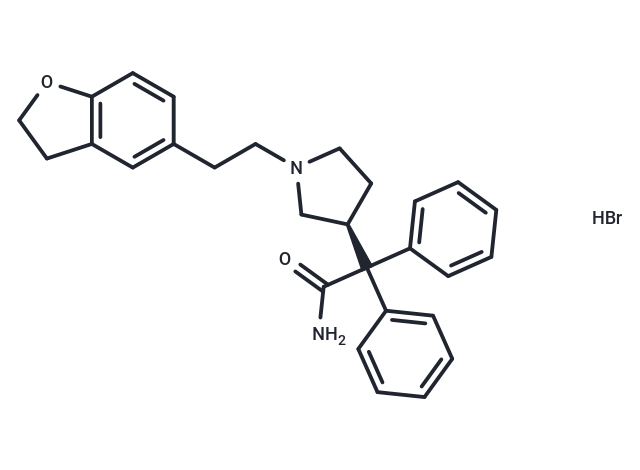Shopping Cart
Remove All Your shopping cart is currently empty
Your shopping cart is currently empty
Darifenacin hydrobromide (UK-88525) is a selective muscarinic receptor antagonist used to treat urinary incontinence and overactive bladder syndrome.

| Pack Size | Price | USA Warehouse | Global Warehouse | Quantity |
|---|---|---|---|---|
| 25 mg | $31 | In Stock | In Stock | |
| 50 mg | $42 | In Stock | In Stock | |
| 100 mg | $50 | In Stock | In Stock | |
| 500 mg | $113 | - | In Stock | |
| 1 mL x 10 mM (in DMSO) | $29 | In Stock | In Stock |
| Description | Darifenacin hydrobromide (UK-88525) is a selective muscarinic receptor antagonist used to treat urinary incontinence and overactive bladder syndrome. |
| Targets&IC50 | M3 mAChR:8.9(pKi) |
| In vitro | Darifenacin exerts non-parallel rightward displacement of the agonist curve and also significant depression of the maximum response (+)-cis-Dioxolane produced concentration-dependent contraction of the isolated bladder of rat. [1] Darifenacin produces a concentration dependent increase in R123 (P-gp probe) accumulation in MDCK cells. Darifenacin stimulates ATPase activity in P-gp membrane in a clear concentration dependent response manner with an estimated ED50 value of 1.6?μM. Darifenacin (100 nM) shows a significantly greater permeability for darifenacin in the basolateral to apical direction resulting in an efflux ratio in BBMEC monolayers of approximately 2.6. [2] |
| In vivo | Darifenacin produces dose-dependent inhibition of amplitude of volume-induced bladder contractions(VIBCAMP), producing 35% inhibition at dose of 283.3 nmol/kg and maximal inhibition of approximately 50–55%. [1] Darifenacin (0.1 mg/kg i.v.) reduces bladder afferent activity in both Aδ and C fibers in female Sprague-Dawley rats, the decrease in afferent spikes in C fibers may be more pronounced than that in Aδ fibers. [3] Darifenacin (7.5 mg and 15 mg, daily) reduces the number of incontinence episodes per week from baseline by 67.7% and 72.8% respectively compared with 55.9% with placebo in patients with overactive bladder (OAB). Darifenacin (7.5 mg and 15 mg, daily) also shows significantly superior to placebo for improvements in micturition frequency, bladder capacity, frequency of urgency, severity of urgency and number of incontinence episodes leading to a change in clothing or pads in patients with overactive bladder (OAB). [4] |
| Synonyms | UK-88525, Darifenacin HBr |
| Molecular Weight | 505.45 |
| Formula | C28H31BrN2O2 |
| Cas No. | 133099-07-7 |
| Smiles | c1cccc(c1)C(c1ccccc1)([C@H]1CN(CC1)CCc1cc2c(cc1)OCC2)C(=O)N.Br |
| Relative Density. | no data available |
| Storage | Powder: -20°C for 3 years | In solvent: -80°C for 1 year | Shipping with blue ice/Shipping at ambient temperature. | |||||||||||||||||||||||||||||||||||
| Solubility Information | H2O: < 1 mg/mL (insoluble or slightly soluble) DMSO: 93 mg/mL (183.99 mM), Sonication is recommended. Ethanol: < 1 mg/mL (insoluble or slightly soluble) | |||||||||||||||||||||||||||||||||||
| In Vivo Formulation | 10% DMSO+40% PEG300+5% Tween 80+45% Saline: 3.3 mg/mL (6.53 mM), Sonication is recommended. Please add the solvents sequentially, clarifying the solution as much as possible before adding the next one. Dissolve by heating and/or sonication if necessary. Working solution is recommended to be prepared and used immediately. The formulation provided above is for reference purposes only. In vivo formulations may vary and should be modified based on specific experimental conditions. | |||||||||||||||||||||||||||||||||||
Solution Preparation Table | ||||||||||||||||||||||||||||||||||||
DMSO
| ||||||||||||||||||||||||||||||||||||
| Size | Quantity | Unit Price | Amount | Operation |
|---|

Copyright © 2015-2025 TargetMol Chemicals Inc. All Rights Reserved.